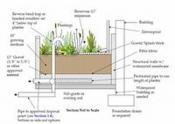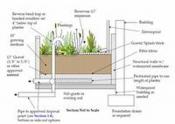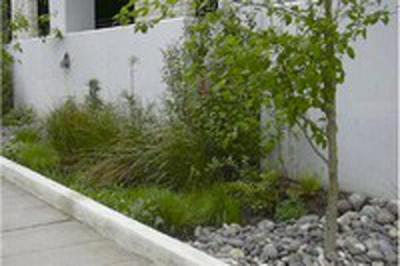Planter Boxes
Planters are structural landscaped reservoirs used to collect and filter stormwater runoff. Infiltration planters allow water to infiltrate through the planter soil and into the ground. Flow through planters include the use of a waterproof lining, and include an overflow to an approved stormwater conveyance system. Both types of planters may be used to help fulfill site landscaping requirements.

Specification
Infiltration planter
Infiltration planters are appropriate for soils with a minimum infiltration rate of 2 inches per hour (typically soils classified as A or B by the National Resource Conservation Service). Minimum planter size is 30 inches wide, with a minimum storage depth of 12 inches. Water should fully drain from the planter within 12 hours, and an overflow to an approved conveyance system is required. River rock, gravel, or some other energy dissipater is required at the water entrance point.
Planter walls must be made of durable, non-toxic material that fits with the surrounding site. Chemically treated wood that can leach out chemicals into stormwater shall not be used. The planter must contain 18 inches of growing medium underlain by 12 inches of gravel, with filter fabric between the layers.
Required setbacks for infiltration planters are 5 feet from property lines and 10 feet from building foundations.

Flow-Through Planters
Flow-through planters are appropriate for all soil types. Minimum planter size is 18 inches wide with a minimum storage depth of 12 inches. Water should fully drain from the planter within 12 hours into an approved conveyance system. River rock, gravel, or some other energy dissipater is required at the water entrance point. An overflow shall be set 4 inches below the top of the planter, and a perforated pipe will be embedded in gravel below the planter to dispose of the water that filters through the planting medium.
Planter walls must be made of durable, non-toxic material that fits with the site plan, and can be incorporated into the foundation walls. Chemically treated wood that can leach out chemicals into stormwater cannot be used. The planter will contain 18 inches of growing medium underlain by 12 inches of gravel, with filter fabric between the layers.
If the planter is located immediately adjacent to a building, a waterproof membrane and other waterproofing, as needed, shall be used to protect the building. Planters must be set back 5 feet from property lines, unless they are less than 30 inches tall.
Planting Specifications
The minimum plant materials per 100 square feet of facility area for both flow through and infiltration planters are:
- 4 large shrubs/small trees (3-gallon containers or equivalent)
- 6 shrubs/large grass-like plants (1-gallon containers or equivalent)
- Ground cover plants planted 12 inches on center, or seed or sod.
Tree planting is encouraged in or near planters, where practical.
Maintenance Requirements
Annually: As needed:
- Remove any debris or garbage caught in the planter facility
- Inspect and replace damaged downspout and overflow pipe
- Remove sediment built up in the planter
- Inspect and replace any damaged, diseased, or dead plants
- Inspect and replace damaged splash guards/erosion control measures
- Inspect for structural integrity and proper function and repair any deficiencies
Planter Box Locations in Sandy
None at this time
Resources Used
- City of Gresham Department of Environmental Services Stormwater Division. Water Quality Manual. Summer 2003.
- City of Oregon City. City of Oregon City Stormwater and Grading Design Standard; Chapter 5 of City Code.
- City of Portland Bureau of Environmental Services. Stormwater Management Manual. July 1, 1999; Revised 2004
- Clean Water Services. Design and Construction Standards for Sanitary Sewer and Surface Water Management. March 2004.
- Sound Native Plants. Environmental Conditions Favorable for Establishment of Outplanted/Transplanted Plants. 2000.
- Additional information and resources are available on the City of Portland Bureau of Environmental Services web page

